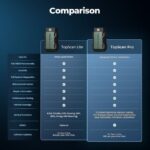Understanding your 2003 Mitsubishi Lancer’s onboard diagnostics system is crucial for both routine maintenance and performance tuning. The OBD2 (On-Board Diagnostics II) port is your gateway to this system, allowing you to read trouble codes, monitor engine parameters, and even enhance your driving experience with aftermarket gauges. Locating this port is the first step to unlocking a wealth of information about your vehicle’s health and performance.
Finding Your 2003 Mitsubishi Lancer OBD2 Port
For the 2003 Mitsubishi Lancer, the OBD2 port is typically located in the driver’s side footwell area. You won’t need any tools to access it, making diagnostics quick and straightforward.
- Get into the Driver’s Seat: Position yourself comfortably in the driver’s seat of your 2003 Lancer.
- Locate the Lower Dashboard: Look under the steering wheel and towards the lower part of the dashboard.
- Search for the Port: The OBD2 port is usually situated within a few inches of the steering column, often near the hood release lever or fuse box. It’s a 16-pin, trapezoid-shaped connector. You might need to crouch down slightly to get a clear view.
- Check for a Cover: In some cases, the OBD2 port may have a small protective cover. If present, gently flip it open to reveal the port.
Once you’ve located the OBD2 port, you’re ready to connect a compatible scan tool or OBD2 gauge to access your vehicle’s diagnostic information.
What Can You Do with the OBD2 Port?
The OBD2 port in your 2003 Mitsubishi Lancer provides access to a wide range of data and functionalities:
- Diagnostic Trouble Codes (DTCs): When your car’s check engine light illuminates, the OBD2 system stores DTCs that pinpoint the source of the problem. Reading these codes helps you understand what’s wrong and take appropriate action.
- Real-time Data Monitoring: OBD2 scanners and gauges can display live data from your engine and other vehicle systems. This includes parameters like:
- Engine Speed (RPM)
- Vehicle Speed
- Coolant Temperature
- Intake Air Temperature
- Throttle Position
- Ignition Timing
- Battery Voltage
- And much more
- Performance Measurement: Some OBD2 devices can measure performance metrics like acceleration times (0-60mph, 0-100mph) and braking performance.
- Customization and Tuning: While more advanced, the OBD2 port can also be used for ECU (Engine Control Unit) tuning and customization, allowing for adjustments to engine parameters for improved performance or fuel efficiency.
Enhancing Your 2003 Lancer with an OBD2 Gauge
For drivers who want to continuously monitor their 2003 Mitsubishi Lancer’s performance and vital signs, an OBD2 gauge is an excellent addition. These gauges plug directly into your OBD2 port and display real-time data in an easy-to-read format.
Products like the P3 V3 Gauge offer a seamless way to integrate performance monitoring into your Lancer. These gauges often feature:
- Plug and Play Installation: Simply connect to your OBD2 port – no complex wiring needed.
- OEM Integration: Designed to blend seamlessly with your car’s interior, often fitting into existing vents for a clean look.
- Versatile Readouts: Display a wide range of parameters, including boost pressure (if applicable), temperatures, speeds, and more.
- Code Reading and Clearing: Many gauges also allow you to read and clear diagnostic trouble codes directly.
Alt Text: P3 V3 OBD2 Gauge installed in a car vent, displaying boost pressure and other parameters.
The P3 V3 Gauge, for example, offers a multitude of readouts, all configurable to your preferred units (Imperial or Metric):
- Boost (OBD2 or Analog Sensor)
- Coolant Temperature
- Vehicle Speed (with Calibration)
- Intake Air Temperature
- Throttle Angle
- Ignition Timing
- Engine RPM
- Exhaust Gas Temperature (EGT)
- Battery Voltage
- Programmable Shift Light
- Analog Inputs for Additional Sensors
- Acceleration and Braking Timers
Alt Text: A bright and clear display of the P3 V3 OBD2 Gauge showcasing various real-time engine readouts like RPM, speed, and temperature.
By utilizing the OBD2 port and a gauge like the P3 V3, you gain valuable insights into your 2003 Mitsubishi Lancer’s performance and health, empowering you to maintain your vehicle effectively and enjoy a more informed driving experience.
Conclusion
Locating the OBD2 port in your 2003 Mitsubishi Lancer is a simple task that unlocks a powerful diagnostic and monitoring capability. Whether you’re checking for trouble codes, tracking performance data, or installing a feature-rich gauge like the P3 V3, understanding and utilizing your OBD2 port is essential for any 2003 Lancer owner who wants to stay informed about their vehicle’s condition and optimize its performance.
